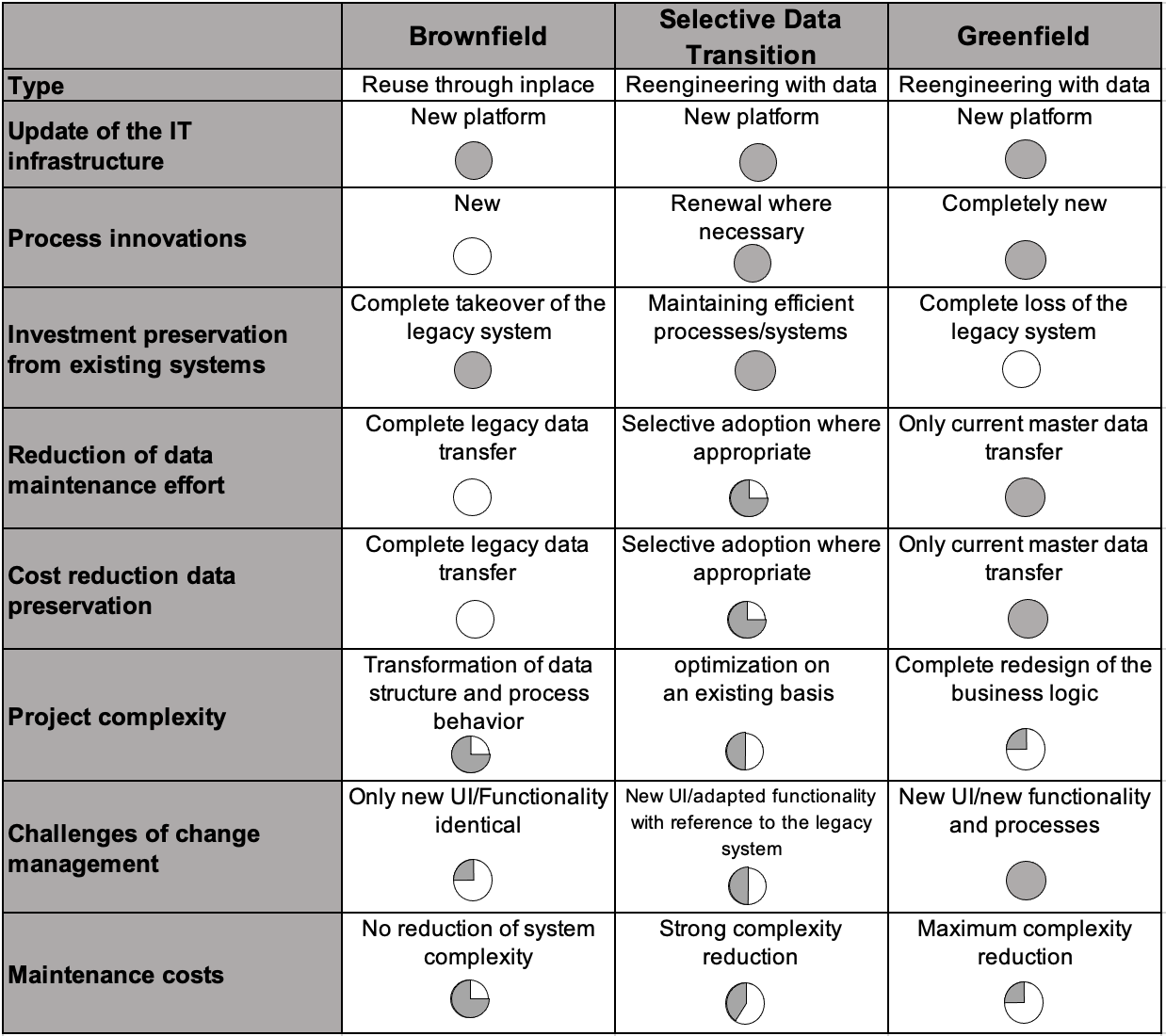

SAP S/4HANA Transformation
Home > Challenges > SAP S/4HANA Transformation
Are you planning to move to SAP S/4HANA?
For many companies today, it is a necessity to take full advantage of the many opportunities offered by digitization in their day-to-day business. This is the only way they can develop their company further and establish new business models. Only this way can they also secure or further expand competitive advantages in the long term. The necessary conditions for this change are created by modern IT landscapes such as the cloud-based real-time ERP suite SAP S/4HANA.
Actual status of existing ERP systems
ERP systems are the heart of many companies. Numerous data and business processes originate there. The larger a company is, the larger its ERP system usually is or will be. As a consequence, the systems become more and more complex. This not only reduces maintainability, but also efficiency, which in turn increases operating costs. In addition, it is often difficult to train new employees in historically grown systems due to unwieldy user interfaces and many processes that have been individualized over the years. If the performance of your ERP system is declining and new processes can only be implemented using costly workarounds, one should become alert. Because these are signs of outdated systems - and a need for a system change.


Migration to SAP S/4HANA
Faster & more flexible processes with the right transformation approach: The BMW Group also decided to move to SAP S/4HANA, including completely new structures. Read more in our success story.
DownloadThree migration strategies to move to SAP S/4HANA
Greenfield, Brownfield, or Selective Data Transition – these are the pros and cons
Choosing the right migration strategy is essential for the success of your transformation. After all, it sets the framework for your project and thus directly influences the adherence to time and budget targets. Overall, you can choose between three different migration methods to get to SAP S/4HANA:
1. Brownfield-approach
In the brownfield approach, the existing overall system with all existing data and processes is migrated to SAP S/4HANA. This method is suitable if you are satisfied with your legacy system and the dataset is kept up to date. This is the case, for example, if the last transformation of existing systems (in the case of company acquisitions or sales) happened not too long ago. However, if you are not satisfied with the status regarding legacy data and processes, this can quickly become a cost driver for your migration. And without you ultimately benefiting from the desired added value of the new environment for your company.
2. Greenfield-approach
With the greenfield approach, you start with a completely new S/4HANA installation. In this case, the system is set up independently of the legacy system and only the current data is migrated. The advantage of this is the possibility to start anew in terms of processes and data structure. The disadvantage: Historical customer and order data that is still needed could require a complex conversion project. This is because the data would have to be transferred almost manually. In addition, previous investments in the SAP ECC system are lost with the greenfield method. It is also a challenge for change management in the company.
3. Selective Data Transition
Between the two very opposing migration strategies, there is a third strategy called Selective Data Transition (SDT) - also known at Natuvion as the ALLFIELD™ approach. This is a hybrid of the brownfield and greenfield methods that combines their advantages and minimizes restrictions. It allows you to transfer all the data and processes you need while at the same time benefiting from technological innovations. In the Selective Data Transition, the existing SAP ECC system is transferred to SAP S/4HANA as a functionalshell. Subsequently, the required data is migrated and legacy data is archived or deleted. The Selective Data Transition is an ideal opportunity for you to check established processes and data for up-to-dateness and quality and, if necessary, update them with best practices from the new environment.
The three migration strategies at a glance
 6 reasons that speak for the Selective Data Transition
6 reasons that speak for the Selective Data Transition
1. Focus on relevant data / processes
2. Reduced project duration and costs
3. Lower risk through targeted process takeover
4. Reduced burden through step-by-step approach
5 .Process innovation in line with demand
6. Low system maintenance costs
What to expect in a typical SDT project
5 project phases to the goal
If you decide on the Selective Data Transition, you can expect the following five project phases at Natuvion:
1. Discover
In the first step, we work together with you to determine the relevant migration objects, the data usage, and volume, and the processes to be migrated, including all changes. Based on this, we give you a recommendation for the future system environment including the test- and production environment.
2. Prepare
We then set up the transformation environment and -software and create an action plan in which the responsibilities are recorded. For a smooth transition to live operation, we also recommend an appropriate test strategy.
3. Explore
In the next step, we coordinate the required technical processes for data migration individually for your project and define a security concept for the data protection architecture. At this point, the framework for the cutover - the concrete conversion of the system - is also defined.
4. Realize
In the penultimate step, we implement the procedure agreed with you. The transformation software is configured, the GRC rules are updated, and anonymization and pseudonymization functions are implemented within the framework of data protection. Subsequently, we perform data migration test cycles and you perform end-to-end process tests. Based on these tests, the migration rules and settings are adjusted.
5. Deploy / Run
In the final step, we work together with you to simulate the conversions to live operation in accordance with the cutover plan. This is controlled via agile processes and the entire system, including all GRC and data protection components, is finally tested. Due to the phased approach and intensive preparation, the go-live almost always runs smoothly.

" With Natuvion's expertise and specialized software, we were able to transform extremely large ERP and CRM systems - with minimal business impact and very high quality.”
Sibylle Diederich
E.ON Program Manager

Why Natuvion?
Extensive experience and the right tools
From our years of experience and expertise, we have developed a repeatable, field-tested concept for transformation processes. This not only guarantees our customers more stability and a higher success rate in the project, but also creates cost advantages. Are you wondering how we achieve this?
The heart of our model and at the same time our distinguishing feature is the in-house Natuvion Data Conversion Server (DCS). This is where we run our intelligent, cloud-based transformation software. With the Natuvion DCS, we accelerate and automate the activities of your transformation processes. For example, it supports your project team in integrated quality assurance through automated testing. In addition, the Natuvion DCS provides a tamper-proof audit trail of all activities for control purposes through your auditors.
Another success factor is the organization of our employees in functional teams according to business units and industries, e.g. for HCM/Payroll or Utilities. In this way, you benefit from our experts' deep and established understanding of your individual requirements for data structures and process modeling.
And we are also officially part of the SAP transformation elite: As one of only four companies worldwide, we have been part of the Selective Data Transition Engagement (SDTE) Community since 2018. In this working group, we jointly define best practices for the transformation to SAP S/4HANA. Our collaboration with SAP product management and the SAP teams is very close.


Your path to SAP S/4HANA
Are you still considering which approach might be right for you? In our whitepaper, we show you in detail the advantages and disadvantages of the 3 migration methods - and compare them with Selective Data Transition. Learn how you can reduce costs, disruptions and the duration of your migration project!
DownloadSAP S/4HANA at a glance
The most important questions
What is SAP S/4HANA?
SAP S/4HANA is a cloud-based ERP software solution. You get location and device-independent access to your data. Business processes can be analyzed and improved in real-time, ensuring faster data processing. Moving to the cloud ensures that your ERP system will perform at a high level at all times.
What is the difference between SAP HANA and SAP S/4HANA?
SAP HANA is an application platform and database. It forms the basis and backbone for the SAP S/4HANA ERP system. Thanks to in-memory technology, SAP HANA can be used as a permanent data store and processes large amounts of data in real time. The database consists of thousands of tables in which the data is permanently stored in the data center. In-memory technology enables transactional (OLTP) and analytical (OLAP) operations to be executed simultaneously at high speed.
As a business suite, SAP S/4HANA exclusively uses the SAP HANA database to analyze and manipulate processes and data in real time.
What will be the impact when SAP ERP support ends in 2027??
By ending SAP ERP support, SAP wants to encourage its existing customers to switch to the new SAP S/4HANA platform. For new customers, SAP S/4HANA will become attractive because SAP will concentrate all resources on the further development of this platform in the future. The discontinuation of support will not have any direct impact on existing products, but the product will no longer be developed further and SAP will no longer carry out any bug fixes. This represents a considerable risk and a potentially high cost for customers who do not make the switch in good time.
Contact
Would you like to learn more about the SAP S/4HANA transformation? Simply fill out the contact form and we will get in contact with you as soon as possible.